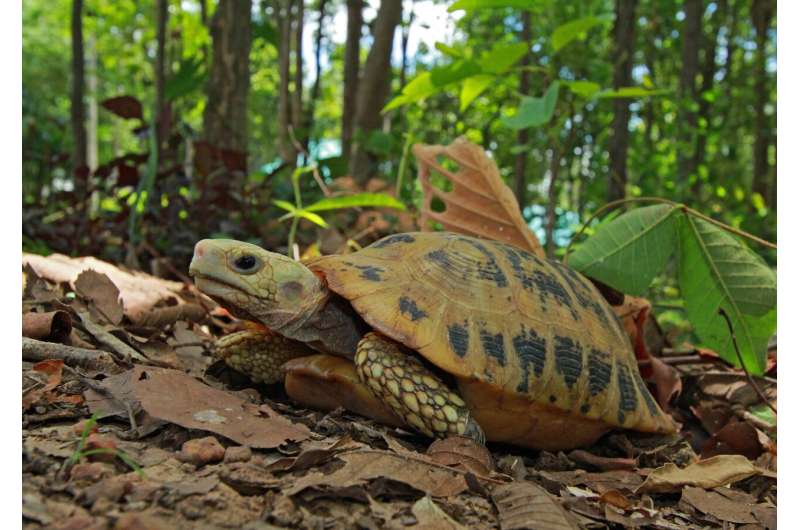This article has been reviewed according to Science X's editorial process and policies. Editors have highlighted the following attributes while ensuring the content's credibility:
fact-checked
trusted source
proofread
Elongated tortoises exhibit minimal genetic variation, aiding conservation efforts

The genetic homogeneity of the endangered elongated tortoise aids the species' protection, as demonstrated in a study by Senckenberg researchers and an international team, published in the journal Salamandra.
Despite their wide distribution in Southeast Asia, the tortoises show hardly any genetic differences. This could be because prehistoric humans spread the species beyond its natural range when using it as a food source.
Today, the tortoises are considered highly endangered due to habitat loss and unsustainable harvest for consumption and trade. However, their genetic uniformity simplifies conservation efforts, including breeding programs, population reinforcement, and reintroductions.
The Indo-Burma region hosts a diverse array of terrestrial ecoregions, ranging from subtropical humid deciduous dipterocarp forests and tropical coniferous forests to temperate and mixed forests, as well as mangroves.
"This biodiversity hotspot is unique in the world," explains Dr. Flora Ihlow, a former postdoctoral researcher at the Senckenberg Natural History Collections in Dresden who now works at the Technical University of Dresden. "The impressive diversity of species in this region, is the result of a complex tectonic, climatic, and geological past."
One of these species is the widespread elongated tortoise (Indotestudo elongata), which Ihlow has now studied in greater detail together with Professor Uwe Fritz from the Senckenberg Natural History Collections and an international team.
The elongated tortoise reaches a carapace length of about 30 centimeters and is considered the most abundant tortoise species in the Indo-Burma region. "Across its range, the species varies significantly in size, shape, and coloration. We wanted to determine whether individuals also show genetic differences and if these differences correspond to their region of origin," says Ihlow.
To this end, the team analyzed three mitochondrial gene fragments from 52 individuals. In addition, they examined 166 adult tortoises,79 males and 87 females, from Vietnam, Cambodia, Myanmar, and Thailand for 42 morphometric and two color characteristics.
"Surprisingly, despite the tortoises' wide distribution across several biogeographic barriers, we could not detect any genetic differentiation in animals from different areas of origin—this is very unusual for a terrestrial and not particularly mobile vertebrate from the Indo-Burma region," says Fritz.
"Therefore, our central questions were how the elongated tortoise maintains genetic connectivity across its wide range and why the species did not evolve into regionally distinct populations."
The researchers suspect that humans played a decisive role in the tortoises' distribution—even across natural biogeographic barriers. Fossil remains of Indotestudo elongata indicate that humans already made intensive use of the animals as a food source about 40,000 years ago, during the late Pleistocene.
Today, the omnivorous tortoise is considered highly endangered due to habitat loss, overcollection and trade, both nationally and internationally. This tortoise species is one of the most frequently traded, primarily sold for human consumption. Over the past 90 years, the population has declined by at least 80%.
"The elongated tortoise is therefore in urgent need of effective conservation measures. Interestingly, the lack of genetic differences is beneficial in this context, as it eliminates the risk of mixing distinct genetic lineages.
"This greatly aids conservation measures such as breeding programs, reintroductions, and population reinforcement. The earlier displacement by humans therefore proved helpful for the protection of the species today," states Fritz.
More information: Flora Ihlow et al, Unexpected lack of genetic and morphological divergence in a widespread tortoise – Phylogeography of Indotestudo elongata, Salamandra (2024). www.salamandra-journal.com/ind … ra,-v-deepak-u-fritz


















